10 Best Plate Chillers
I’ve tested several plate chillers for brewing, and the top performers include the 60-plate Ferroday for maximum efficiency and the 40-plate BestEquip B3-12A for compact setups. These stainless steel units cool wort from boiling to fermentation temperature in minutes rather than hours, using less water than immersion chillers. Key factors include plate count (30-60 plates), 304 stainless steel construction, and proper connection fittings. Below, you’ll discover detailed performance comparisons and selection criteria.
We are supported by our audience. When you purchase through links on our site, we may earn an affiliate commission, at no extra cost for you. Learn more. Last update on 24th December 2025 / Images from Amazon Product Advertising API.
Notable Insights
- Plate chillers cool wort from boiling to fermentation temperature in minutes, dramatically reducing cooling time compared to traditional methods.
- Models with 30-60 plates offer superior heat transfer efficiency, with higher plate counts providing faster and more effective cooling performance.
- Stainless steel construction with copper brazing ensures durability, corrosion resistance, and reliable operation across extreme temperature ranges.
- Compact designs use significantly less water than immersion chillers while providing better cooling efficiency and space-saving benefits.
- Most plate chillers require pumps for optimal performance and filters to prevent clogging, with easy cleaning through simple rinsing.
BestEquip Heat Exchanger 3×7.5 40 Plates Brazed Plate (B3-12A)

The BestEquip Heat Exchanger B3-12A stands out as the top choice for home brewers who need efficient wort chilling without breaking the bank. This compact unit measures 8.3 x 7.1 x 3.9 inches and weighs just 5 pounds, making it easy to handle during brewing sessions. You’ll appreciate the 316L stainless steel construction that withstands high pressure and temperature while resisting corrosion. The corrugated plate design creates turbulent flow, which dramatically improves heat transfer efficiency compared to traditional cooling methods. With 40 brazed plates and 3/4 MPT connections, you can quickly chill your wort to pitching temperature without wasting water or time.
Best For: Home brewers and small-scale operations who need efficient, compact wort chilling and heating applications without requiring electricity.
Pros:
- Durable 316L stainless steel construction resists corrosion and handles high pressure/temperature conditions
- Compact turbulent flow design maximizes heat transfer efficiency in a small 5-pound footprint
- Versatile applications beyond brewing including HVAC, industrial cooling, and hydronic heating systems
Cons:
- Limited to 3/4 MPT connections which may require adapters for some plumbing configurations
- 40-plate capacity may be insufficient for larger commercial brewing operations
- No built-in temperature control requiring external monitoring during use
MRbrew Wort Chiller 30 Plates, Brazed Plate Copper Heat Exchanger for Homebrew

Homebrewers seeking rapid wort cooling will find the MRbrew 30-plate chiller transforms their brewing timeline from hours to minutes. You’ll appreciate the enhanced surface area that cold water covers, delivering faster cooling than traditional immersion chillers. The efficient design conserves water while aerating your wort during flow, eliminating needs for separate aeration equipment.
This chiller’s 304 stainless steel construction, brazed with pure copper in oxygen-free conditions, guarantees rust-free operation without leak risks. You can rely on its performance across extreme temperatures from -321°F to 392°F. The 1/2 male NPT quick disconnect fittings provide low restriction flow, working perfectly with pumps for gravity transfers and flexible mounting options during your brewing process.
Best For: Homebrewers who want to dramatically reduce wort cooling time from hours to minutes while conserving water and eliminating the need for separate aeration equipment.
Pros:
- Cools wort in minutes instead of hours with 30-plate design that maximizes cold water surface area contact
- Uses less water than other chillers while simultaneously aerating wort, eliminating need for aeration stones and CO2 canisters
- Durable 304 stainless steel construction with pure copper brazing ensures rust-free, leak-proof operation across extreme temperatures (-321°F to 392°F)
Cons:
- Higher upfront cost compared to simple immersion chillers
- Requires pump for optimal performance and gravity transfers, adding complexity to brewing setup
- More complex internal design may be harder to clean thoroughly compared to simple immersion coil chillers
FERRODAY Wort Chiller, 30 Plate Stainless Steel Heat Exchanger for Homebrew

Serious homebrew enthusiasts who demand rapid wort cooling will find the FERRODAY 30 Plate Stainless Steel Heat Exchanger delivers professional-grade performance in a compact 7.3 x 2.8 inch package. You’ll appreciate how its 30 brazed plates chill your wort within minutes, unlike immersion chillers that require hours. The 304 stainless steel construction with 99.9% copper brazing guarantees durability and efficient heat transfer while reducing oxidation risks.
Setup requires connecting the wort-in port to your mash tun and wort-out port to your fermenter, plus you’ll need a wort pump for transfer. For maintenance, run five gallons of cleaning solution followed by clear water through the unit, then dry thoroughly before storage.
Best For: Serious homebrew enthusiasts who want professional-grade rapid wort cooling and are willing to invest in a pump-based system for efficient heat exchange.
Pros:
- Chills wort within minutes compared to hours with immersion chillers, dramatically reducing cooling time
- Compact 7.3 x 2.8 inch design with durable 304 stainless steel construction and 99.9% copper brazing
- Reduces oxidation risks during the chilling process while providing efficient heat transfer
Cons:
- Requires a wort pump for operation, adding to equipment costs and complexity
- Cannot be disassembled for thorough cleaning, limiting maintenance options
- Needs filter installation to prevent clogging and is not suitable for viscous liquids
BestEquip Brazed Plate Heat Exchanger (B3-12A)

Beer enthusiasts and HVAC professionals will find exceptional value in the BestEquip B3-12A Brazed Plate Heat Exchanger, a compact powerhouse that delivers turbulent flow efficiency in just 5 pounds. You’ll appreciate its 316L stainless steel construction, which handles high pressure and temperature while resisting corrosion. The corrugated plate design maximizes heat transfer within its 8.3 x 7.1 x 3.9-inch footprint, making it perfect for tight spaces. You can use this versatile unit for beer wort chilling, hydronic heating, industrial oil cooling, and HVAC applications. The 3/4 MPT connections guarantee easy installation, while the brazed construction eliminates gasket maintenance concerns completely.
Best For: Beer brewing enthusiasts and HVAC professionals who need a compact, high-efficiency heat exchanger for wort chilling, hydronic heating, or industrial cooling applications in tight spaces.
Pros:
- Durable 316L stainless steel brazed construction eliminates gasket maintenance and handles high pressure/temperature
- Compact corrugated plate design maximizes heat transfer efficiency while maintaining a small 8.3 x 7.1 x 3.9-inch footprint
- Versatile applications including beer wort chilling, HVAC systems, and industrial oil cooling with easy 3/4 MPT connections
Cons:
- Limited to 40 plates which may not provide sufficient capacity for larger commercial applications
- 3/4 MPT connections may require adapters for systems using different thread types or sizes
- Lightweight 5-pound construction may not be suitable for heavy-duty industrial applications requiring larger heat exchange capacity
Ferroday Wort Chiller, 60 Plate Stainless Steel Heat Exchanger for Homebrew
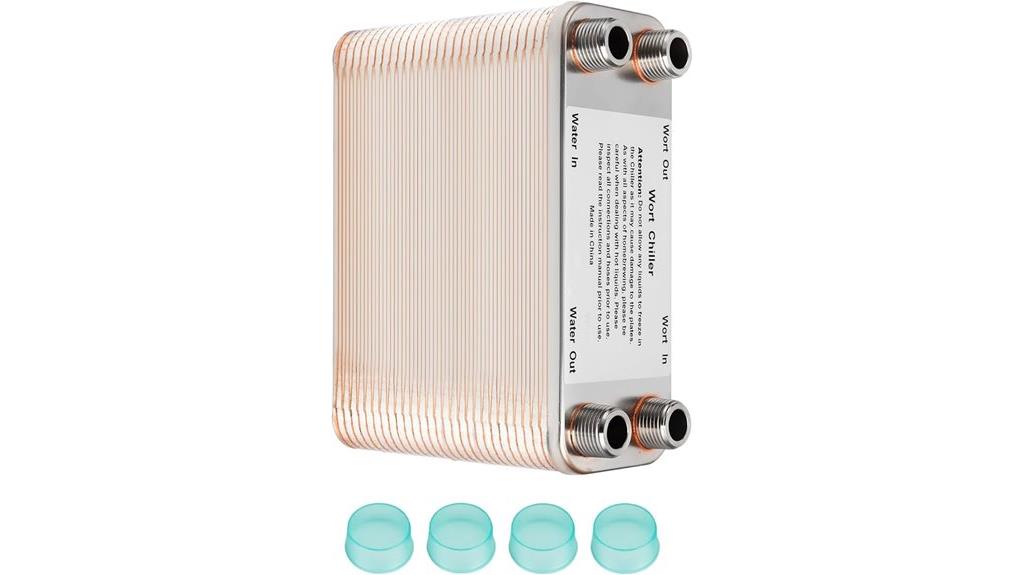
Brewing enthusiasts who demand rapid wort cooling will find the Ferroday 60-plate stainless steel heat exchanger delivers exceptional performance in a compact design. This 7.5 x 5.6-inch unit cools boiling wort to fermentation temperature within minutes, dramatically reducing cooling time compared to immersion chillers. You’ll appreciate the 304 stainless steel construction with 99.9% copper brazed plates, which provides food-grade safety while maximizing cooling surface area. The standard 1/2 NPT thread ports connect easily to most home brewing setups and water pumps. You should install a filter to prevent clogging, as this exchanger works best with non-viscous liquids like wort, beer, and water.
Best For: Homebrewing enthusiasts who want to rapidly cool wort from boiling to fermentation temperature in minutes while maintaining flavor integrity and brewing efficiency.
Pros:
- Extremely fast cooling performance with 60 brazed plates that chill wort from boiling to fermentation temperature within minutes
- Durable food-grade construction using 304 stainless steel with 99.9% copper brazed plates for superior heat transfer and oxidation reduction
- Compact 7.5 x 5.6-inch design with standard 1/2 NPT thread ports for easy integration with most home brewing setups
Cons:
- Requires installation of a filter to prevent clogging, adding complexity to the setup
- Not suitable for viscous liquids, limiting its versatility beyond standard brewing applications
- May require a water pump connection, potentially increasing overall system costs
Wort Chiller 50 Plates Brazed Plate Heat Exchanger for Homebrew
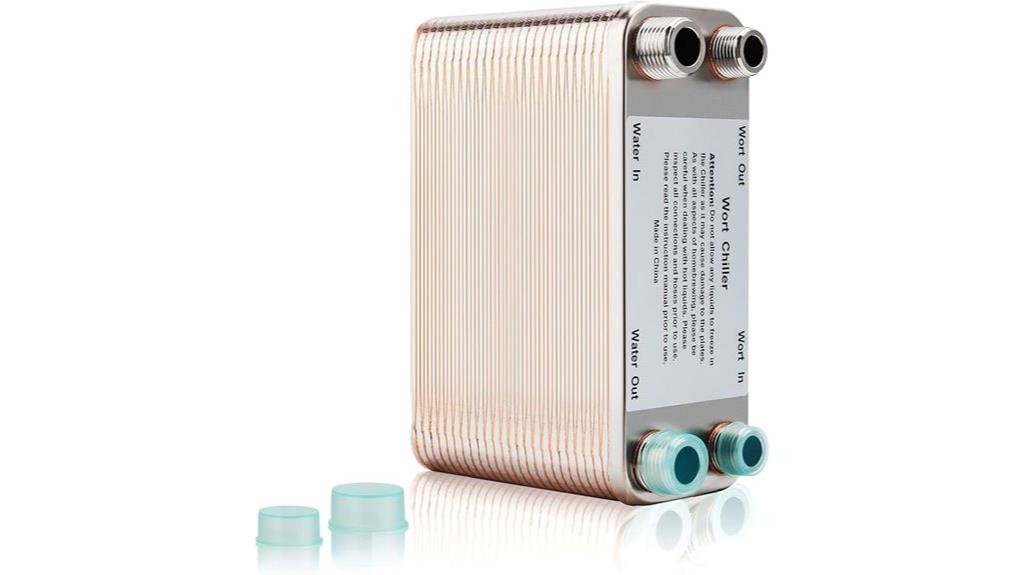
Homebrewers seeking rapid wort cooling will find the 50-plate brazed heat exchanger transforms their post-boil process from a lengthy wait into a matter of minutes. This stainless steel unit measures 7.5 x 2.9 inches with 1/2 and 3/4 NPT thread connections, delivering superior cooling efficiency compared to immersion chillers. You’ll appreciate the 304 stainless steel construction brazed with pure copper, which operates reliably from -321°F to 392°F without leaks or rust. The design reduces water usage markedly, particularly beneficial if you’re brewing in warmer climates. Simply rinse with cleaning solution for maintenance, and the low-restriction design works perfectly with pumps or gravity transfers.
Best For: Homebrewers who want to rapidly cool their wort in minutes rather than hours, especially those in warmer climates looking to reduce water usage and improve brewing efficiency.
Pros:
- Extremely fast cooling performance that chills wort in minutes compared to traditional immersion chillers
- Durable 304 stainless steel construction with copper brazing that operates from -321°F to 392°F without leaks or rust
- Low-restriction design that works well with pumps or gravity transfers while significantly reducing water usage
Cons:
- Requires cleaning of inlets/outputs before first use to remove metal debris from manufacturing
- More complex than simple immersion chillers, potentially requiring familiarity with pump systems for optimal performance
- Higher upfront cost compared to basic wort cooling methods
MRbrew Wort Chiller 40 Plates Heat Exchanger for Homebrew
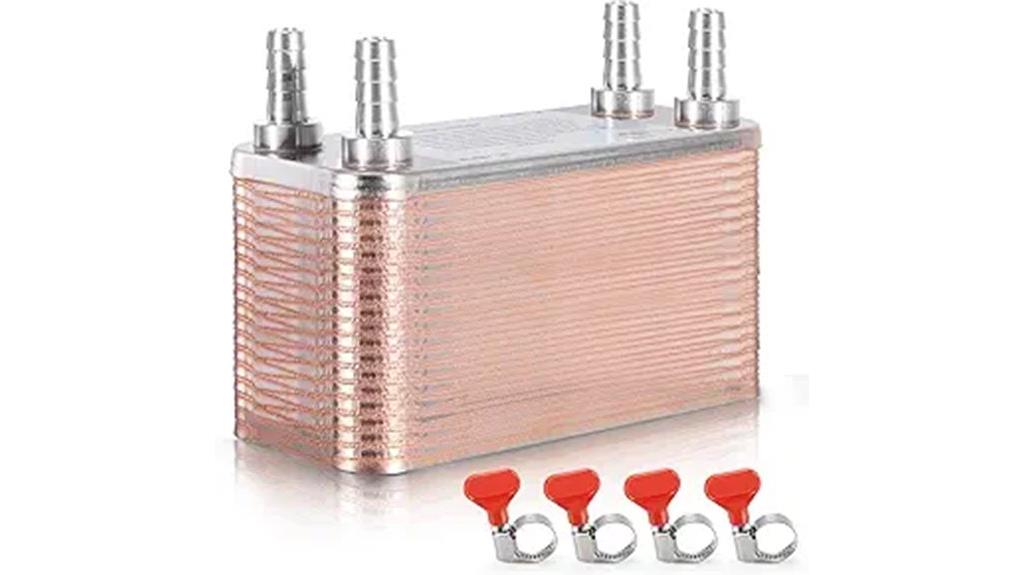
Efficiency transforms your cooling process when you choose the MRbrew Wort Chiller, a 40-plate brazed copper heat exchanger that delivers professional-grade performance for home enthusiasts. This compact 7.5 x 2.9-inch unit cools your wort in minutes by circulating liquid between 304 stainless steel and pure copper plates. You’ll use less water than traditional immersion chillers while achieving faster results. The 1/2-inch barb fittings connect directly to standard hoses without additional accessories. Temperature resistance spans from -321°F to 392°F, and the oxygen-free furnace brazing prevents leaks and rust. Cleaning requires only a simple rinse with cleaning solution and water between brewing sessions.
Best For: Home brewers and laboratory users who want professional-grade wort cooling performance with faster results and reduced water consumption compared to traditional immersion chillers.
Pros:
- Cools wort in minutes with superior efficiency by maximizing cold water surface area and circulating wort between 40 copper plates
- Saves water and costs while offering direct 1/2-inch hose connection without additional accessories needed
- Exceptional durability with leak and rust resistance through oxygen-free furnace brazing and extreme temperature tolerance (-321°F to 392°F)
Cons:
- Compact 7.5 x 2.9-inch size may limit cooling capacity for very large batch brewing operations
- Requires cleaning solution rinses between brewing sessions for proper maintenance
- Initial investment cost may be higher than basic immersion chiller alternatives
Wort Chiller 40 Plates Brazed Plate Copper Heat Exchanger for Homebrew
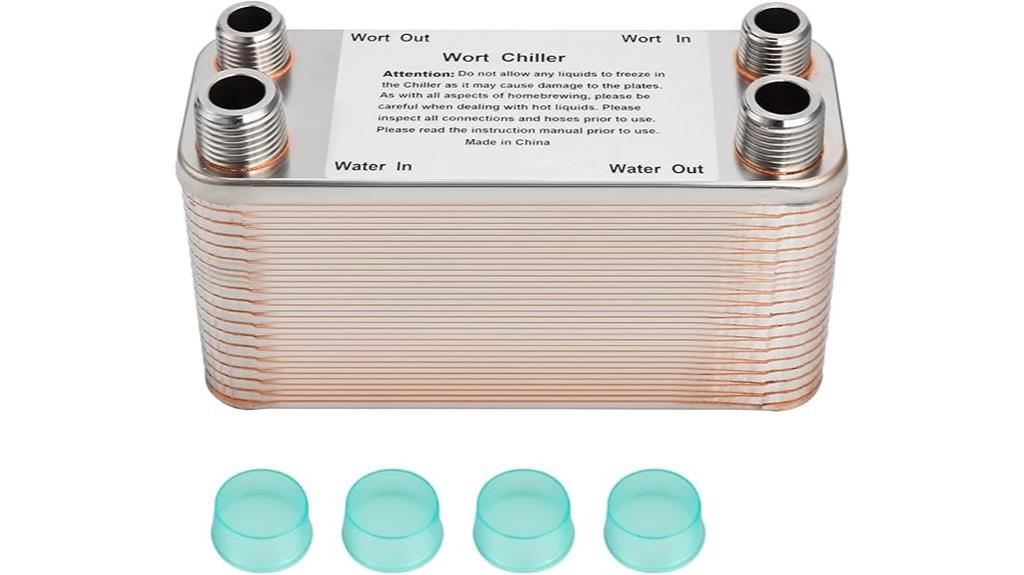
When time matters most in your brewing process, the Wort Chiller 40 Plates delivers rapid cooling that transforms hours into minutes. This brazed plate copper heat exchanger measures 7.5 x 2.9 inches and weighs 4 pounds, making it compact yet powerful for homebrew operations. You’ll appreciate the 304 stainless steel construction with pure copper brazing that prevents leaks and rust completely.
The chiller features 1/2 and 3/4 male NPT quick disconnect fittings for easy connection. You’ll use less water than comparable chillers while achieving superior cooling performance. The low restriction design works perfectly with pumps, enhancing gravity transfer and increasing flow rates considerably. Cleaning requires only a simple rinse with cleaning solution and water between uses. The lifetime warranty backs every unit.
Best For: Homebrewers who need rapid wort cooling in minutes rather than hours, especially those in warmer climates who want to conserve water while achieving superior heat exchange efficiency.
Pros:
- Cools wort in minutes with superior performance compared to immersion chillers while using less water
- Durable 304 stainless steel construction with pure copper brazing prevents leaks and rust completely
- Low restriction design works seamlessly with pumps and gravity systems, plus easy cleaning with lifetime warranty
Cons:
- Requires cleaning inlets and outlets before use to prevent metal debris contamination
- Higher upfront cost compared to basic immersion chillers
- Compact 4-pound unit may have limited capacity for very large batch brewing operations
FERRODAY 40 Plate Wort Chiller, Stainless Steel Heat Exchanger for Brewing
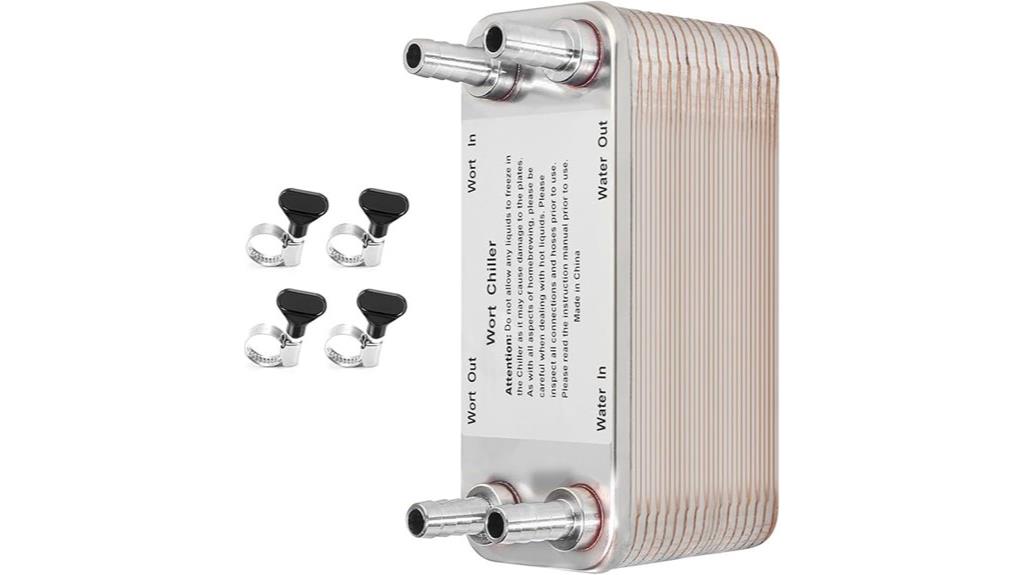
The FERRODAY 40 Plate Wort Chiller transforms your brewing process with its impressive cooling speed, making it ideal for serious home brewers who want professional-grade results. You’ll cool your wort from boiling to fermentation temperature within minutes, not hours like traditional immersion chillers.
This 7.5 x 3.8-inch unit features 40 brazed plates made from food-grade 304 stainless steel with 99.9% copper brazing. You’ll connect the wort-in port to your mash tun and wort-out port to your fermenter, using a wort pump for transfer. The upgraded 1/2 barb fittings work with standard hoses, and included clamps prevent leaks. Clean by running 5 gallons of cleaning solution through it.
Best For: Serious home brewers who want professional-grade cooling efficiency and are willing to invest in a higher-end plate chiller system that requires a wort pump for operation.
Pros:
- Dramatically faster cooling time – reduces wort cooling from hours to minutes compared to immersion chillers
- High-quality construction with food-grade 304 stainless steel plates and 99.9% copper brazing for durability and minimal oxidation
- Easy setup with upgraded 1/2 barb fittings that work with standard hoses and includes all necessary clamps for secure connections
Cons:
- Requires a wort pump for proper operation, adding to the overall system cost and complexity
- Cannot be disassembled for thorough cleaning, which may be concerning for some brewers who prefer deep cleaning access
- Not suitable for viscous liquids and requires filtration to prevent clogging, limiting versatility
MRbrew Wort Chiller 60 Plates for Homebrew Beer Cooling
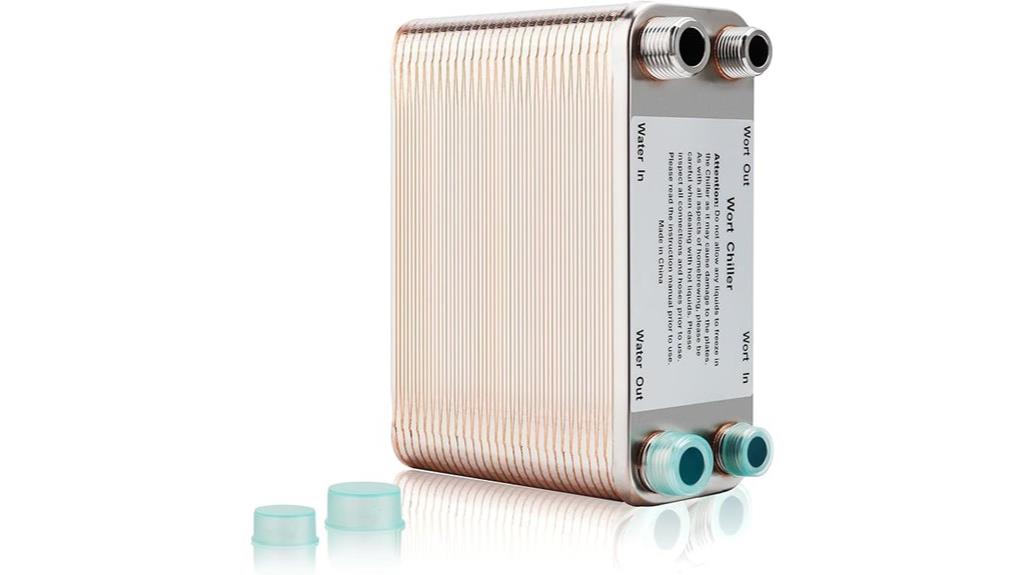
Homebrewers who want faster cooling times and water savings will find the MRbrew 60-plate wort chiller particularly valuable for their brewing setup. You’ll appreciate how this chiller outperforms immersion models by running wort between plates, which increases surface area contact with cold water. The 304 stainless steel construction with copper-brazed plates handles extreme temperatures from -321°F to 392°F without leaking or rusting. You can connect it easily using the included 1/2″ and 3/4″ male NPT quick disconnect fittings. The design aerates your wort during cooling, eliminating your need for additional aeration equipment. You’ll also use less water while achieving faster cooling.
Best For: Homebrewers seeking faster wort cooling times, water conservation, and elimination of additional aeration equipment in their brewing process.
Pros:
- Faster cooling than immersion chillers due to increased surface area contact between wort and cold water through plate design
- Water-efficient operation that uses less water while providing superior cooling performance compared to other chiller types
- Eliminates need for separate aeration equipment since the design aerates wort during the cooling process
Cons:
- May require pump compatibility considerations due to its low restriction design, potentially adding equipment costs
- Higher upfront investment compared to basic immersion chillers despite long-term water savings
- Plate design may be more complex to clean thoroughly compared to simple immersion chiller coils
Factors to Consider When Choosing Plate Chillers
When I’m selecting a plate chiller for my brewing setup, I need to evaluate several critical factors that directly impact performance and long-term satisfaction. The plate count determines cooling efficiency, while material construction quality affects durability, and connection port compatibility guarantees proper integration with my existing equipment. I also must consider my cooling water requirements and how easily I can clean and maintain the unit during regular use.
Plate Count Efficiency
One of the most critical factors affecting your plate chiller’s performance is the number of plates it contains, as this directly determines the available surface area for heat exchange. More plates mean better cooling efficiency, allowing you to reach target temperatures faster. For instance, chillers with 30 to 60 plates can cool wort to fermentation temperature within minutes rather than hours.
I’ve found that increasing plate count enhances turbulent flow, which improves heat transfer rates markedly. Different plate configurations also optimize flow paths, ensuring uniform cooling throughout your system. However, you’ll need to balance plate count with your specific flow rate requirements. Too many plates can increase pressure drop and system complexity (making maintenance more challenging), so consider your cooling needs carefully before deciding.
Material Construction Quality
Beyond plate count, the materials used in your chiller’s construction will determine its longevity, safety, and overall performance. I recommend choosing plate chillers made from stainless steel grades 304 or 316L. The 304 grade contains 18% chromium and 8% nickel, offering solid oxidation resistance for most applications. However, 316L provides superior corrosion resistance thanks to added molybdenum, making it ideal for harsh conditions.
Look for brazed plates combining stainless steel with copper brazing. This copper enhancement boosts thermal conductivity and improves heat exchange efficiency. The construction should feature oxygen-free brazing techniques to prevent oxidation and maintain structural integrity over time.
Most importantly, verify your chiller uses food-grade certified materials. This certification guarantees safe contact with consumable liquids while minimizing contamination risks during food preparation.
Connection Port Compatibility
How effectively will your plate chiller integrate with your existing food processing setup? Connection port compatibility determines whether you’ll have seamless operation or frustrating installation problems. Most food processing equipment uses standardized thread sizes like 1/2 NPT or 3/4 NPT fittings, so I recommend confirming your chiller matches these specifications.
Quick disconnect fittings offer significant advantages for frequent setup and removal while reducing leak risks during operation. You’ll want to verify that fitting dimensions match your hoses or pipes to prevent water flow restrictions or connectivity issues.
I suggest choosing chillers with low restriction designs, which improve flow rates and enhance cooling efficiency. Don’t forget to check compatibility with additional accessories like pumps, which maintain consistent pressure and optimize performance throughout your food processing operations.
Cooling Water Requirements
After guaranteeing proper connections, you’ll need to understand your plate chiller’s cooling water requirements to achieve ideal performance. I recommend maintaining consistent water flow rates through your system, as irregular flow reduces heat exchange efficiency. The temperature difference between your cooling water and hot food matters considerably—greater differences improve cooling performance. You’ll find plate chillers generally use less water than immersion alternatives, making them economical (especially in warmer climates where conservation counts). Establish proper plumbing without flow restrictions, as these directly impact cooling effectiveness. Consider your chiller’s design specifications, including plate count and surface area, since these determine water requirements. Optimizing these factors guarantees efficient heat transfer while minimizing water waste.
Cleaning Maintenance Ease
When selecting a plate chiller, you’ll discover that cleaning maintenance ease can make or break your brewing experience. Most chillers require only a simple rinse with cleaning solution and water to maintain effective performance. I recommend establishing proper cleaning schedules since many models feature one-time assembly designs that can’t be disassembled for deep cleaning.
Quick-connect fittings dramatically reduce setup and cleaning time, letting you switch between brewing sessions without extensive downtime. Consider models that recommend using filters to prevent clogging during operation, which maintains excellent performance standards.
Regular maintenance prolongs your chiller’s lifespan while enhancing durability and heat exchange efficiency. This consistent care guarantees your plate chiller delivers reliable cooling performance throughout countless brewing sessions.
Frequently Asked Questions
How Often Should I Clean and Sanitize My Plate Chiller?
I recommend cleaning your plate chiller after every use and sanitizing it weekly if you use it regularly. Rinse with warm water immediately after each brewing session, then wash with brewery cleaner. For sanitization, I use a no-rinse sanitizer like Star San every seven days or before extended storage periods to prevent bacterial buildup and contamination.
What’s the Average Lifespan of a Brazed Plate Heat Exchanger?
I’ve found that brazed plate heat exchangers typically last 15-20 years with proper maintenance and usage. The lifespan depends on factors like water quality, operating temperatures, and cleaning frequency. If you maintain proper flow rates and avoid exceeding temperature limits, you’ll get maximum longevity. Regular descaling and inspection help prevent corrosion and scaling that can reduce efficiency and shorten the unit’s operational life considerably.
On a final note
I’ve covered eight top plate chillers that’ll keep your homebrew at the perfect temperature. Each model offers different plate counts and materials to match your specific cooling needs. Remember to take into account your batch size, available space, and budget when making your choice. The 30-plate models work well for beginners, while 60-plate units handle larger batches efficiently. Choose stainless steel for durability or copper for better heat transfer.
